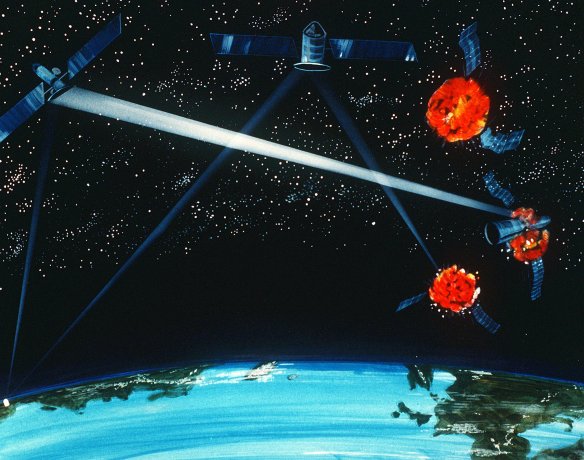Artists rendering of one of the Strategic Defense Initiative designs from Los Alamos National Laboratory. It shows a space-based particle beam weapon attacking enemy intercontinental ballistic missiles. (U. S. Department of Energy)
Space-based, antiballistic missile (ABM) system endorsed by U. S. President Ronald Reagan in 1983 as a way to neutralize the Soviet nuclear threat. Nicknamed “Star Wars” by its critics and the media, the Strategic Defense Initiative (SDI) foresaw the use of satellites, mirrors, and lasers that would detect, track, and destroy incoming nuclear missiles. Reagan believed that the SDI might force the Soviets to engage in nuclear arms reduction talks and serve as a partial solution to the threat posed by the nuclear arms race.
To counter the Soviet threat in the 1950s, the United States began work on an ABM system. Various incarnations emerged during the 1960s and early 1970s, until the United States and the Soviet Union signed the 1972 Anti- Ballistic Missile Treaty. This treaty limited the deployment of ABM systems to only two operational areas and stipulated that such a system could not protect the entire nation. Nevertheless, work continued in both nations to develop an effective means of nullifying an enemy nuclear attack.
Reagan had many motivations for pursuing the SDI. In principle, he disagreed with the concept of mutual assured destruction (MAD). MAD held that because of the catastrophic nature of thermonuclear war, any nation that initiated a nuclear exchange was guaranteed to suffer complete destruction in a counterstrike. Reagan believed that MAD was immoral and unacceptable. He was further motivated by the upcoming 1984 election and his desire not to be seen as a warmonger. Deploying a defensive system would demonstrate his desire to end the arms race.
Among those who supported the SDI were military contractors who stood to make money developing and deploying such a system. Other supporters included Robert McFarlane, Reagan’s national security advisor during 1983-1985, who believed that the SDI could be used as a bargaining chip to motivate the Soviets to scale back their missile production. Opponents of the SDI, including some Reagan administration officials, mockingly nicknamed the plan “Star Wars” after the popular science fiction film series.
In a televised address on 23 March 1983, Reagan publicly announced his desire to pursue the SDI. The scientific task was difficult, he admitted, but the rewards would be worth it: a United States whose citizens did not have to live in fear of nuclear destruction. The SDI would be costly, perhaps in the trillions of dollars. Reagan lobbied his friend and ally British Prime Minister Margaret Thatcher, who initially opposed the SDI but eventually came to see it as a good idea.
Unlike previous ABM systems, the SDI would provide missile defense from space. In fact, to intercept missiles in flight, space-based weapons were the best option, because land-based weapons could not overcome the problems presented by the curvature of Earth. Because Soviet long-range missiles took only thirty minutes to reach their targets, there was just enough time to detect, track, and intercept the warheads before they reentered the atmosphere. As Reagan described it and as scientists conceived it, the SDI would employ a number of satellites and space-based radars to detect and track incoming missiles and land- or satellite-based lasers reflected off orbital mirrors to destroy a warhead in flight. Scientists planned lasers that would employ X-ray, infrared, ultraviolet, or microwave radiation. They also conceived of particle-beam weapons in which streams of charged atomic matter would be directed at incoming warheads.
From the perspective of some, particularly new Soviet leader Mikhail Gorbachev, the SDI was a great threat. When Reagan and Gorbachev first met in Geneva in 1985, the SDI proved the sticking point on any arms control agreements. Gorbachev fiercely objected to the SDI, arguing that such a system only made sense if the United States planned to launch a nuclear first-strike against the Soviet Union. Gorbachev also well understood that the Soviet Union lagged behind the United States in computer technology, an area crucial to such an advanced weapons system. For the Soviet Union to allow the SDI to move forward would be to admit defeat. Gorbachev therefore insisted that Reagan give up the SDI before agreements on limiting offensive weapons could be reached. Reagan refused, but he also told Gorbachev that the SDI was necessary and that when it was finally completed, he would share the technology with the Soviets. Gorbachev did not believe Reagan, and Reagan could see no logical argument against the SDI. Because of the SDI, the two men departed Geneva without a deal on arms control.
The Reagan administration ultimately failed to develop and deploy the SDI. The technology proved too daunting, and the costs were too high. Still, the mere threat of the SDI put tremendous pressure on the Soviets. Some scholars attribute the Soviet Union’s 1991 collapse to Reagan’s vigorous pursuit of the SDI. Others, however, regard the SDI as a costly boondoggle that only escalated Cold War tensions and contributed to swollen defense allocations and mammoth budget deficits.
References Duric, Mira. The Strategic Defense Initiative: U. S. Policy and the Soviet Union. Burlington, VT: Ashgate, 2003. Fitzgerald, Frances. Way Out There in the Blue: Reagan, Star Wars, and the End of the Cold War. New York: Simon and Schuster, 2000. Waller, Douglas C. The Strategic Defense Initiative, Progress and Challenges: A Guide to Issues and References. Claremont, CA: Regina Books, 1987.
